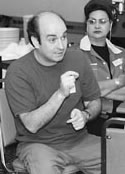|
CalWIN Work a New Classification December 2002
CalWIN requires a new way of doing work and therefore a new classification. Prior to CalWIN, an applicant would enter the waiting room, go to a window, and meet a clerical worker who would enter the clientís name into the computer to check for a prior history. The client would then be given an application with a booklet explaining the process and their rights, having the option of filling out the form in the waiting room or at their leisure. The applicant would return with the completed application and necessary documentation. The client would then attend an orientation where they would have the opportunity to ask questions of an information and referral social worker. Following the orientation, the applicant would meet with the eligibility worker to review the application and make sure all required documentation was present. If the applicant was missing documentation, they could leave and later return with the missing items, such as birth certificates, car registration, rent receipts, bank account statements, employment verification, etc. The eligibility worker would then assess what referrals would be appropriate for the applicant and their family. If there were any issues of domestic violence, drugs or alcohol, mental health, physical or learning disabilities they would be referred to a social worker. If the applicant appeared employable they would be referred to an employment counselor. A typical intake interview with a client would take an hour to an hour and a half. After the client left, the worker would process the application to determine eligibility for the various programs and calculate the grant amount. This process would take an hour or more. The worker could be in charge of determining eligibility for only one program, or they may be a generic worker who has to know the regulations for all the programs, eligibility, food stamps, Medical, TANF, general assistance, and disabilities. Under the CalWIN model the above functions would be compressed into one long interview. The clerical, informational and referral orientation, and application processing would all be performed by the CalWIN worker. The applicant would drop in and immediately meet with the CalWIN worker, who would interview the client and enter the responses into a computer in real time. The process requires the worker and applicant to go through 285 computer screens, and it is estimated that it will take about three hours. At the end of the interview, the completed application is printed and the client signs it. The role of supervisors would change as well. Under the old model the supervisorís role was to review cases for accuracy and completeness, and to coach workers who need assistance. Under the new model, the computer system would assist the eligibility worker in self-reviewing the case. Help screens and online tutorials would guide the worker through problems. The supervisorís role would be to gather statistics, and generate reports on productivity and the demographics of clients. The computer could also monitor the amount of time it takes workers to complete certain tasks and gather other productivity information. The CalWIN workers would assume some of the eligibility supervisorís functions as well. Given these changes in function and work organization, the union is taking the position that CalWIN workers need a different classification than the old eligibility worker classification.
|
|||||||||

